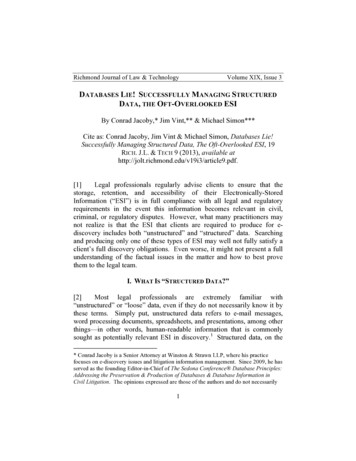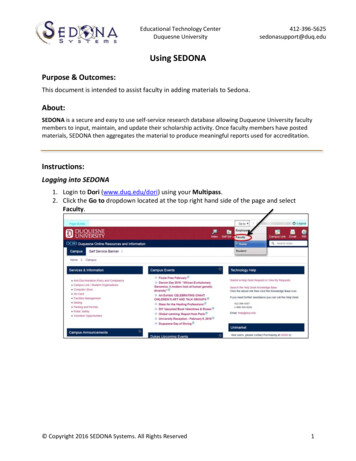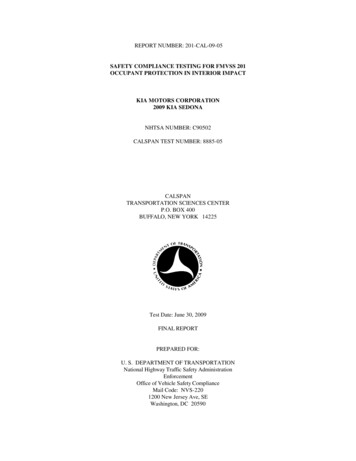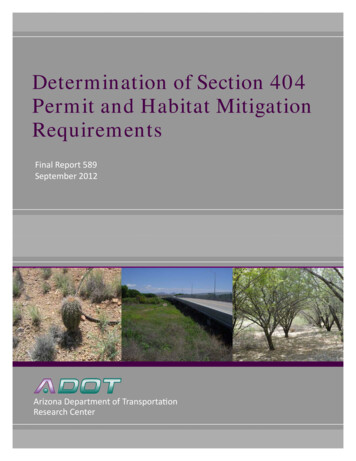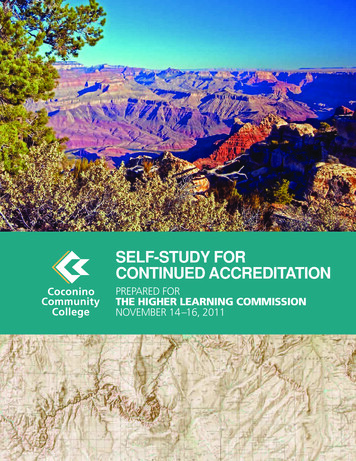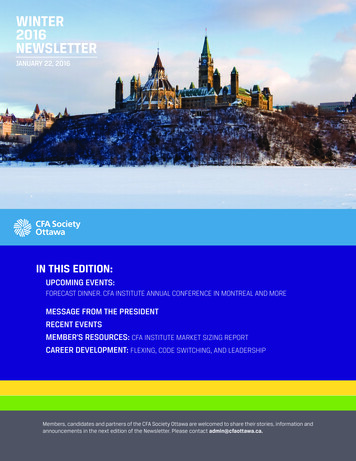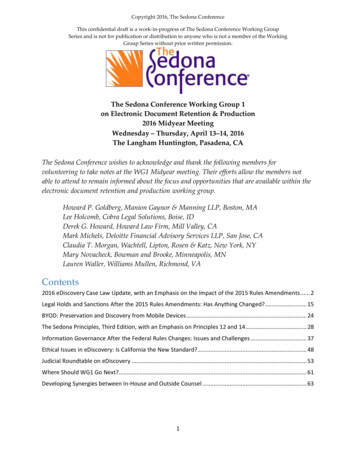
Transcription
Copyright 2016, The Sedona ConferenceThis confidential draft is a work-in-progress of The Sedona Conference Working GroupSeries and is not for publication or distribution to anyone who is not a member of the WorkingGroup Series without prior written permission.The Sedona Conference Working Group 1on Electronic Document Retention & Production2016 Midyear MeetingWednesday – Thursday, April 13–14, 2016The Langham Huntington, Pasadena, CAThe Sedona Conference wishes to acknowledge and thank the following members forvolunteering to take notes at the WG1 Midyear meeting. Their efforts allow the members notable to attend to remain informed about the focus and opportunities that are available within theelectronic document retention and production working group.Howard P. Goldberg, Manion Gaynor & Manning LLP, Boston, MALee Holcomb, Cobra Legal Solutions, Boise, IDDerek G. Howard, Howard Law Firm, Mill Valley, CAMark Michels, Deloitte Financial Advisory Services LLP, San Jose, CAClaudia T. Morgan, Wachtell, Lipton, Rosen & Katz, New York, NYMary Novacheck, Bowman and Brooke, Minneapolis, MNLauren Waller, Williams Mullen, Richmond, VAContents2016 eDiscovery Case Law Update, with an Emphasis on the Impact of the 2015 Rules Amendments . 2Legal Holds and Sanctions After the 2015 Rules Amendments: Has Anything Changed? . 15BYOD: Preservation and Discovery from Mobile Devices . 24The Sedona Principles, Third Edition, with an Emphasis on Principles 12 and 14 . 28Information Governance After the Federal Rules Changes: Issues and Challenges . 37Ethical Issues in eDiscovery: Is California the New Standard?. 48Judicial Roundtable on eDiscovery . 53Where Should WG1 Go Next?. 61Developing Synergies between In-House and Outside Counsel . 631
Copyright 2016, The Sedona ConferenceThis confidential draft is a work-in-progress of The Sedona Conference Working GroupSeries and is not for publication or distribution to anyone who is not a member of the WorkingGroup Series without prior written permission.2016 eDiscovery Case Law Update, with an Emphasis on theImpact of the 2015 Rules AmendmentsModerator (M):Kenneth J. Withers, The Sedona Conference, Phoenix, AZWith assistance from several WG1 membersIntroduction to ProportionalityRemember where we were in 1978: probably in a disco wearing bell-bottomed sequinedtrousers. This was Rule 26(b) then:(B) SCOPE OF DISCOVERY. Unless otherwise limited by order of the court inaccordance with these rules, the scope of discovery is as follows:(1) In General. Parties may obtain discovery regarding any matter, not privileged,which is relevant to the subject matter involved in the pending action, whether it relatesto the claim or defense of the party seeking discovery or to the claim or defense of anyother party . . . It is not grounds for objection that the information sought will beinadmissible at the trial if the information sought appears reasonably calculated to leadto the discovery of admissible evidence.The leading Supreme Court case on the definition of “relevance” was handed down bythe Supreme Court that year, and it is still the leading case: Oppenheimer Fund, 437 U.S.340, 351 (1978). It was actually a Rule 23 case, not Rule 26, and involved asking a thirdparty to create a list of stockholders for a potential securities class action. The court heldthat the list of stockholders fell within the broad scope of discovery, with reference toRule 26, but that the requesting party should pay the third party for the list (which wasan early example of ESI), and not require the producing party to pay for it. Here’s theoperative language referencing Rule 26:“The key phrase in this definition—’relevant to the subject matter involved in thepending action’—has been construed broadly to encompass any matter that bears on, orthat reasonably could lead to other matter that could bear on, any issue that is or maybe in the case. See Hickman v. Taylor, 329 U.S. 495, 501, 67 S.Ct. 385, 388, 91 L.Ed. 451(1947). Consistently with the notice-pleading system established by the Rules, discoveryis not limited to issues raised by the pleadings, for discovery itself is designed to helpdefine and clarify the issues. Id., at 500–501, 67 S.Ct. at 388. Nor is discovery limited to2
Copyright 2016, The Sedona ConferenceThis confidential draft is a work-in-progress of The Sedona Conference Working GroupSeries and is not for publication or distribution to anyone who is not a member of the WorkingGroup Series without prior written permission.the merits of a case, for a variety of fact-oriented issues may arise during litigation thatare not related to the merits.”Oppenheimer is still good law – judges are still routinely quoting Oppenheimer, andtrying to shoehorn it into the current Rule 26. The prime example is State Farm Mut.Auto. Ins. Co. v. Fayda, 14 Civ. 9792, 2015 WL 7871037 (S.D.N.Y. Dec. 3, 2015), decidedimmediately after the new Rule 26 went into effect. An insurance carrier filed suitagainst several healthcare providers, alleging that they submitted fraudulent claims. Indiscovery, the plaintiff sought production of bank records, tax returns, leases, paymentrecords, and other financial information from the defendants, who objected on the basisof relevance and privacy. The court invoked the amended Rule 26(b)(1), but quoted the1978 Supreme Court decision in Oppenheimer Fund for the proposition that “[r]elevanceis still to be ‘construed broadly to encompass any matter that bears on, or thatreasonably could lead to other matter that could bear on’ any party's claim or defense.”This is a separate consideration from proportionality, and “the amended rule isintended to ‘encourage judges to be more aggressive in identifying and discouragingdiscovery overuse’ by emphasizing the need to analyze proportionality before orderingproduction of relevant information,” quoting the 2015 Committee Note to Rule 26(b)(1).Analyzing the specific requests, the court found that they were relevant to the plaintiff’sfraud allegations. Turning to the defendants’ argument that the proposed discoverywas disproportionate, the court noted that the defendants advanced only twoarguments, one being the low value of the case and the second being the private andsensitive nature of the information requested. While the value of the case may bedisputed, only the defendants can provide information on the cost of responding to thediscovery, which they failed to do, as well as failing to provide any alternative sourcefor the information. Regarding privacy interests, courts have been sensitive to this issuein the past, but have ordered discovery when the information is relevant and materialand cannot be obtained from any other source. Finally, the court noted that tone of thesubmissions made by both sides in this dispute has been “overblown and intemperate,”although “[t]he federal rules require, and this Court expects, that counsel will cooperateto resolve any future disputes and will behave respectfully toward each other andtoward the Court.”3
Copyright 2016, The Sedona ConferenceThis confidential draft is a work-in-progress of The Sedona Conference Working GroupSeries and is not for publication or distribution to anyone who is not a member of the WorkingGroup Series without prior written permission.Additional cases citing Oppenheimer, using similar language: Louisiana Crawfish Producers Assoc. v. Mallard Basin, Inc., 2015 WL 8074360 (Dec. 4,2015) Wit v. United Behavioral Health, 2016 WL 258604 (N.D. Cal. Jan. 21, 2016) Henry v. Morgan’s Hotel Group, 2016 WL 303114 (S.D.N.Y. Jan, 25, 2016) Ghorbanian v. Guardian Life Ins. Co., 2016 WL 1077251 (W.D. Wash. Mar. 18, 2016) Green, et al. v. Cosby, 2016 WL 1086716 (E.D. Pa. Mar. 21, 2016)These are all summarized in the materials. The point is that the Oppenheimer definitionof relevance hasn’t gone away or been overruled, it’s just been cabined by the far morenuanced considerations of proportionality. In 1987, “Relevance” equated to“discoverability.” Now the equation is:Discoverability (relevance – privilege) / (proportionality x 6)There are several cases that cite Oppenheimer, but that doesn’t necessarily result in agrant of production:LightSquared v. Deere & Co., 13 Civ. 8157, 2015 WL 8675377 (S.D.N.Y. Dec. 10, 2015). Oneweek later, the same respected U.S. Magistrate Judge who wrote State Farm. In a lawsuitbrought by a broadband network against GPS networks alleging negligentmisrepresentation and constructive fraud in the deployment of technologicallyconflicting broadcast and reception standards that essentially rendered the plaintiffs’network inoperable, the plaintiffs requested the court to order the defendants torespond to several discovery requests to which the defendants raised objections “inevery respect.” While applying the amended Rule 26(b)(1) to define the scope ofdiscovery, and noting that “discovery no longer extends to anything related to the‘subject matter’ of the litigation, the court quoted a 1978 Supreme Court decision,Oppenheimer Fund, Inc. v. Sanders, 437 U.S. 340, for the proposition that relevance isstill to be “construed broadly to encompass any matter that bears on, or that reasonablycould lead to other matter that could bear on” any party's claim or defense. Analyzingthe plaintiffs’ requests in detail, the court noted that the long time frame from whichdiscovery is being sought (2001 through 2012) was relevant to the allegations of fraud or4
Copyright 2016, The Sedona ConferenceThis confidential draft is a work-in-progress of The Sedona Conference Working GroupSeries and is not for publication or distribution to anyone who is not a member of the WorkingGroup Series without prior written permission.misrepresentation, and the objection that nothing will be found is based on thedefendants’ general denial of the plaintiffs’ claims and substitution of their ownnarrower theory of the case. “The defendants' belief that the plaintiffs' case lacks meritis not a basis for curtailing discovery.” Regarding the number of custodians from whichthe plaintiffs requested discovery, the plaintiff failed to specify the custodians fromwhom it was seeking discovery, which the court attributed to the defendants’ failure toproduce documents for the entire relevant time period. Instead of ordering thedefendants to respond to a vague request to search the files of unnamed additionalcustodians, the court ordered the plaintiffs to serve interrogatories requesting theidentities of individuals with knowledge of specific technical issues in dispute, andallow the defendants 21 days to respond, after which the parties will confer on adiscovery plan going forward. Regarding the plaintiffs’ requests for information fromthe defendants on revenue and profits derived from GPS services, the court noted thatclaims for negligent misrepresentation do not require proof of a pecuniary motive, andthe defendants’ revenue and profits would not be relevant to the plaintiffs’ damages.Therefore that line of discovery would be denied. Finally, the court declined to orderthat any specific search terms be used in discovery, citing The Sedona Principles,Principle 6, for the proposition that the parties are in the best position to conduct theirown discovery, and urging the parties to confer and agree on search terms to the extentpossible.United States ex rel. Shamesh v. CA, Inc., No. 09-1600, 2016 WL 74394 (D.D.C. Jan. 6, 2016).In this False Claims Act case, the defendant moved to compel the plaintiff to producedocuments that, among other things, related to the claims for which the plaintiffintended to seek damages. In discussing amended Rule 26(b)(1), the court noted that“[l]ike before, relevance is still to be ‘construed broadly to encompass any matter thatbears on, or that reasonably could lead to other matter that could bear on’ any party’sclaim or defense,” citing Oppenheimer. The court went on to note that the changes toRule 26 simply relocate the proportionality factors to Rule 26(b)(1) to “encourage judgesto be more aggressive in identifying and discouraging discovery overuse” and to makeproportionality considerations unavoidable. After analyzing the document requestspropounded by the defendant, the court found that many of the requests would notreasonably lead to information bearing on the issues in the case and were5
Copyright 2016, The Sedona ConferenceThis confidential draft is a work-in-progress of The Sedona Conference Working GroupSeries and is not for publication or distribution to anyone who is not a member of the WorkingGroup Series without prior written permission.disproportionate to the needs of the case. As a result, the court denied the motion withrespect to eight document requests but granted the motion with respect to one request.Hadfield v. Newpage, No. 5:14-cv-00027, 2016 WL 427924 (W.D. Ky. Feb. 3, 2016). In thisage discrimination suit, the defendants objected to an extension of the discovery cutoffand the production of severance agreements of eleven similarly-situated employees.The court found the extension supported by good cause, given the efforts by theplaintiff to resolve discovery disputes within the deadline. Citing the new Rule 26(b)(1)and Oppenheimer, the court also found that the plaintiff satisfied his burden todemonstrate the relevance of the severance agreements to his claims. However, thecourt held that the plaintiff failed to meet a higher burden of establishing thatdepositions, beyond the presumptive limit of ten, would be proportional to the needs ofthe case.The proportionality analysis can become highly technical and complex, requiring closeattention to the facts of the case, as in Krantz v. State Farm, No. 15-56, 2016 WL 320148(M.D. La. Jan. 25, 2016). This was a lawsuit for bad-faith denial of a residential fireinsurance claim. The plaintiff noticed a Rule 30(b)(6) of the defendant, enumerating 36categories of information on which discovery would be sought. The defendant objectedto the deposition notice as overbroad, and moved for a protective order, and theplaintiff cross-moved to compel. Applying the new Rule 26(b)(1), the court granted theplaintiff’s motion to compel the deposition, but painstakingly analyzed all 36 categoriesof requested information, striking several outright and severally limiting others.A.M. v. American School for the Deaf, 2016 WL 1117363 (D. Conn. Mar. 22, 2016). In anaction against a school and town brought by the parents of a deaf child for use ofexcessive force and violations of the American with Disabilities and Rehabilitation Acts.The plaintiff requested discovery of past police use of excessive force, which the courtheld was not relevant, as the police themselves were not alleged to have directlycommitted the acts complained of, but of relying on the advice and direction of theschool officials. While the requested discovery was not per se irrelevant, it wasdisproportionate to the needs of this case, and would be limited to discovery into policetraining on handling similar incidents.Pertile v. General Motors, 2016 WL 320148 (M.D. La. Jan. 25, 2016). In a personal injuryand vehicle design defect action, the plaintiffs sought production, in native format, of6
Copyright 2016, The Sedona ConferenceThis confidential draft is a work-in-progress of The Sedona Conference Working GroupSeries and is not for publication or distribution to anyone who is not a member of the WorkingGroup Series without prior written permission.GM’s proprietary finite element analysis (“FEA”), a computer simulation model used topredict the impact of various load conditions on vehicles and components. GMobjected, stating that it had already produced 150,000 pages of CAD drawings,engineering analysis reports, and reports from the FEA model. The court noted thatwhile the FEA model “might yield helpful information,” mere relevance was notenough. The court found that the proprietary nature of the FEA model, the attenuationof the model itself from the particular vehicle or the circumstances of the alleged defect,and the availability of more directly relevant evidence, the motion to compel discoverywould be denied.Sprint Comm. Co. LP v. Crow Creek Sioux Tribal Court, No. 4:10-cv-04110, 2016 WL 782247(D.S.D. Feb. 2, 2016). A long-distance telecommunications carrier brought an actionagainst a tribally-owned local carrier for breach of contract. The court entered partialsummary judgment in favor of the plaintiff and awarded immediate damages, butseveral outstanding issues required adjudication and further discovery, governed bythe amended Rule 26(b)(1), which requires particularized showing of relevance andproportionality by the proponent and a showing of specific facts by a party resistingdiscovery on the basis of irrelevance or disproportionality. In this particular case,discovery may require revisiting and updating prior discovery from earlier in theaction, although the court will avoid duplicative discovery. In this highly technicaltelecommunication rate case, the parties will need to focus discovery on the issues thatare essential to the analysis laid out in the controlling FCC precedents. The courtproceeded to examine each disputed discovery requesting, granting cross-motions tocompel and for protective orders in part, and denying them in part, to both parties.Comment: Gone are the days in which a judge can just provide the classic a knee-jerkresponse to a discovery request: “Oh, just give it to them.” On occasion, the court willengage in a complex analysis of the parties’ theories of the case. Example:Roberts v. Clark County School District, No. 2:15-cv-00388, 2016 WL 123320 (D. Nev. Jan.11, 2016). A transgender school police officer filed suit against the school district forgender discrimination and retaliation. The school moved to compel discovery of theplaintiff’s medical records for the past ten years directly from providers, all emailaddresses used by the plaintiff, and the plaintiff’s social media accounts. The plaintiffobjected to the discovery requests on relevance and privacy grounds. The court initially7
Copyright 2016, The Sedona ConferenceThis confidential draft is a work-in-progress of The Sedona Conference Working GroupSeries and is not for publication or distribution to anyone who is not a member of the WorkingGroup Series without prior written permission.cited the pre-2015 version of Rule 26(b)(1) in articulating the scope of discovery,discussing amendments made in 1983 and 2000 to narrow that scope. But the courtwent on to cite the Chief Justice’s 2015 Year-End Report and the 2015 amendments toimpose “reasonable limits on discovery through increased reliance on the commonsense concept of proportionality.” While the central claims of the plaintiff involveemotional distress, and the defendant’s proposed discovery may be relevant toemotional distress in general, the particular claims tie the alleged emotional distress tothe school district’s actions. “The court finds CCSD simply does not need to know theintimate details of his transgender transition process to defend itself on these claims . . .CCSD's requested medical discovery is essentially seeking proof of whether Roberts isbiologically male, and when he developed male anatomy to support its defense that itdid not discriminate against him . . . The court agrees with counsel for Roberts thatCCSD's requests for medical evidence are overbroad because CCSD claims they mightpossibly contain some reference to Roberts' emotional distress or state of mind. Therequests are not narrowly tailored to obtain this information . . . The court will also notrequire Roberts' to identify all of his personal email addresses and social networkingwebsites with account name and corresponding addresses. Interrogatory No. 16 isoverbroad and not narrowly tailored to obtain discoverable information on social mediaabout Roberts' emotional distress relevant to this lawsuit, or other factors in his life thatmay have contributed to his emotional distress during the time period in dispute.However, to avoid a future dispute over a subsequent discovery request, the court willrequire counsel for Roberts to identify all of the social media sites on which Roberts hashad an account from 2011 to the present. The court will also require counsel for Robertsto review the content of those accounts from January 2011, to the present, and toproduce any content” relevant to the claims and defenses in this action. Finally, thecourt declined to award attorneys’ fees and costs to either side, as “the parties hadsubstantial disputes on which reasonable minds could differ.”Comment: This was a gender discrimination case, which is subtly different from a fromsex discrimination case. The defendants were overlaying their own theory onto theclaims, which the court didn’t allow. Discovery would be limited to claims and defensesas actually alleged, not as interpreted by defense, and the defendants were attemptingto expand the scope of the case – a classic “fishing expedition.” Judges are going to beasked to go through the claims / theories in more detail from now on.8
Copyright 2016, The Sedona ConferenceThis confidential draft is a work-in-progress of The Sedona Conference Working GroupSeries and is not for publication or distribution to anyone who is not a member of the WorkingGroup Series without prior written permission.Personnel FilesDiscovery of personnel files emerged as a theme in several recent cases, and it illustratesthe point about proportionality. Two examples:Braud v. Geo Heat Exchangers, LLC, 2016 WL 1274558 (MD La. Mar. 31, 2016). In awrongful termination suit, the plaintiff alleged that he was terminated for complainingof sexual harassment, while the employer stated that he was terminated aftercomplaints from other employees of making racial comments. The plaintiff soughtdiscovery of the entire personnel files of the supervisor who fired him and thecomplaining employees, and of another employee who was also fired for the samereason, “minus payroll, beneficiary, or medical records or personal identifiers.” Thecourt limited the discovery of the supervisor’s file to job duties, performanceevaluations, complaints or investigations of sexual harassment, and disciplinaryrecords. Discovery of the four complaining employees’ records, and the one firedemployee, was limited to complaints, investigations, disciplinary records, andperformance evaluations. The court really cut down what was deemed related to theclaims and defenses.In re Xarelto (Rivaroxaban) Products Liability Litigation, MDL NO. 2592, 2016 WL 311762(E.D. La. Jan. 26, 2016). In this multidistrict pharmaceutical products liability litigation,the plaintiffs requested discovery of the personnel files of the manufacturer’semployees. The defendants objected, citing lack of relevance to the claims and defensesin the litigation and the privacy interests of the employees. The court focused on therelevance that the personnel records might have on the “rush to the market” theory ofliability, weighed against the privacy interests. The plaintiffs attempted to narrow theirrequest to information regarding job performance and limited the request to employeesand former employees who have been deposed in the “bellweather pool.” Thedefendants argued that even this narrower request implicated public policy concerns, asthe confidentiality of supervisor evaluations would be compromised by disclosure. Thecourt found that in the context of a products liability action, a plaintiff cannot discover anon-party employee's personnel file (as opposed to a “custodial file”) without anindividualized showing of relevancy, proportionality, and particularity strong enoughto overcome the privacy interests. The court denied the plaintiffs’ request withoutprejudice, allowing them to file separate motions for in camera review of particularly9
Copyright 2016, The Sedona ConferenceThis confidential draft is a work-in-progress of The Sedona Conference Working GroupSeries and is not for publication or distribution to anyone who is not a member of the WorkingGroup Series without prior written permission.relevant personnel files. “If an in camera review is conducted, this Court will balanceprivacy against the relevancy and particularity of the sought information before it isreleased. Released material may be required to be placed under seal and usedexclusively for purposes of upcoming depositions.”Comments: Distinguish between personnel file discoverability and custodial files.Disclosure can damage the employee / employer relationship, even whenconfidentiality orders are in place. Court held that personnel files were not discoverablebecause of the failure to demonstrate relevance, particularity, and proportionality onwitness by witness basis. Privacy interests are implicated. Significance: importance ofparticularity in request and response.Question re: how to satisfy this in first instance (in case don’t get a second shot)?Response: takeaway is be much more particular and focused in requests; as respondingparty, push back more and open communications re: why requesting party needs ordoesn’t need documents.Possession, Custody, or ControlMatthew Enter., Inc. v. Chrysler Grp., LLC, No. 13-cv-04236, 2015 WL 8482256 (N.D.Cal. Dec. 10, 2015). In a Robinson-Patman Act price discrimination action brought by anauto dealer against the auto manufacturer, the plaintiff was able to produce only threeemails involving potential customers during the relevant time period, and thedefendant moved to compel further production from employees’ personal devices. Theplaintiff objected, saying that these sources of ESI are not within the plaintiff’s“possession, custody, or control.” The court noted that the “practical ability” test hasbeen rejected in the Ninth Circuit, and that the defendant has failed to demonstrate thatthe plaintiff has the legal right to demand that non-party employees surrender theirpersonal devices for discovery. On the other hand, the plaintiff also objected to theproduction of ESI from its customer relations database, which is held by a commercialapplication service provider. The court held that the contract with the service providergave the plaintiff the right to access the data, which it had done in the past, andtherefore the plaintiff had sufficient control over the ESI to be ordered to produce therequested data.10
Copyright 2016, The Sedona ConferenceThis confidential draft is a work-in-progress of The Sedona Conference Working GroupSeries and is not for publication or distribution to anyone who is not a member of the WorkingGroup Series without prior written permission.Comments: Motion to compel two types of ESI: (1) e-mails from personal Gmailaccounts (corporate e-mail not in use), and (2) financial database. Question: did entityhave possession, custody, or control? Re: personal e-mail, answer was NO b/c party waswithout the legal right to access and disclose. For the database, though, the respondingparty had access to data that was hosted by third party. Judge declined to follow the“practical ability” test, citing to Sedona rule 34 commentary. Noted “futility” issue –responding party would not actually be able to fulfill request.Further WG1 member comments: – implications of the e-mail decision on the corporateparty re: not having control of the e-mail – Rule 45 still available to get this information– intersection with BYOD policies and related implications and consequences –production/preservation implications – entity that knows personal accounts are in use –is there an obligation to notify of preservation obligations? Are we shifting to where arule 34 request is no longer sufficient to capture work time or related information that’son employee devices, within employee control? Not necessarily, b/c companies stillhave business needs to keep control of data for security reasons, etc. May differ basedon industry or claims at issue in the matter. Need for dialogue between requesting andresponding party. Difference between non-parties and employees re: preservationobligations. A spectrum of related obligations in play, including whether a party needsto tell an employee or other party of right to independent counsel. Difference betweenobligation and good practices.Social MediaForman v. Henkin, 134 A.D.3d 529 (Sup. Ct. App. Div. 1st Dept. Dec. 17, 2015). In thispersonal injury action stemming from a horseback riding accident, the plaintiff allegedcognitive and physical injuries that limited her ability to participate in social andrecreational activities. The trial court ordered the plaintiff to produce all photographs ofherself posted on Facebook prior to the accident, all photographs of herself postedprivately on Facebook after the accident (except those showing nudity or romanticencounters), and to authorize the defendant to obtain records from Facebook showingeach time plaintiff posted a private message after the accident and the number ofcharacters or words in those messages. On appeal, the Appellate Division held thatrequests for social media must be based on more than “vague and generalizedassertions that information in the plaintiff's social media sites might contradict the11
Copyright 2016, The Sedona ConferenceThis confidential draft is a work-in-progress of The Sedona Conference Working GroupSeries and is not for publication or distribution to anyone who is not a member of the WorkingGroup S
2016 eDiscovery Case Law Update, with an Emphasis on the Impact of the 2015 Rules Amendments Moderator (M): Kenneth J. Withers, The Sedona Conference, Phoenix, AZ With assistance from several WG1 members Introduction to Proportionality Remember where we were in 1978: probably in a disco wearing bell-bottomed sequined trousers.


